AMD Releases Radeon Software Crimson ReLive Edition 17.7.2: ReLive Edition Refined for Gamers and Developers
by Nate Oh on July 26, 2017 5:00 PM ESTRadeon GPU Profiler
In many ways, the new Radeon GPU Profiler (RGP) is the marquee feature for game and software developers in 17.7.2. While select developers (such as teams at DICE, RenderDoc, and Valve) have had early access to RGP for the last couple months as part of a beta program, AMD is publicly announcing and launching RGP today, offering official API support for DX12 and Vulkan, and with Windows 7, Windows 10, and Ubuntu 16.04 (Linux) as the supported OSes. Hardware-wise, RGP is compatible with recent GCN-based products, with the RX 400, RX 500, and Fiji-based cards being officially supported.
AMD compares RGP with enabling a “white box” style console development workflow for GPUs on PC, as opposed to the typical “black box” experience. And before anyone asks, AMD’s experience with console development was only an indirect influence with respect to RGP, although consoles and console tools are also utilizing GCN’s built-in low-level thread trace features. Like how certain changes in Radeon Software came from user feedback, RGP came about due to requests from AMD’s ISV partners who liked those console tools and requested something similar for PC.
In the field of PC GPU performance tuning and debugging, developers will already be familiar with Microsoft’s PIX for Windows, of which AMD has released an AMD plugin this May. While RGP has no direct relation to PIX, it “complements the functionality offered with PIX for Windows, offering additional insight into the GPU not available today in PIX.” Otherwise, the AMD plugin for PIX continues to be actively developed, and is a separate initiative from RGP. Similarly, AMD stated that RGP is not competing with existing solutions like RenderDoc, instead choosing to collaborate with the developers and ensure that RenderDoc and RGP complement each other.
Using GCN’s hardware thread tracing feature, RGP combines that data with information from the driver and application, where a single frame could be presented and visualized as shown in the slide above. For developers, this can lay out what is exactly happening in the GPU and where performance could easily be increased, including analyzing async compute usage, event timing, pipeline stalls, and bottlenecks. With a vast amount of features and functionality, RGP also includes a large amount of documentation and a sample trace to peruse.
As its documentation outlines, RGP itself is actually comprised of four components:
- Radeon Developer Mode Driver – This is shipped as part of the AMD public Crimson driver from 17.30 onwards and supports the developer mode features required for profiling.
- Radeon Developer Service (RDS) – A system tray application that unlocks the Developer Mode Driver features and supports communications with high level tools.
- Radeon Developer Panel (RDP) – A GUI application that allows the developer to configure driver settings and generate profiler trace data from DirectX12 and Vulkan applications.
- Radeon GPU Profiler (RGP) – A GUI tool used to visualize and analyze the trace data.
As mentioned earlier, the Radeon Developer Mode Driver is the heart of RGP, exposing internal driver settings and experimental features that were previously only available to developers on a case-by-case basis. These settings are customizable and allows dumping of trace files for RGP to analyze.
RGP documentation does state that RGP will not work with older APIs such as DX11 and OpenGL. In terms of major known issues, RGP only works on a single AMD GPU, and will not work with Windows Insider Editions, while driver settings for Vulkan are not available yet.
AMD LiquidVR 360 SDK
Building upon last year's LiquidVR additions, AMD has brought yet another asset to the LiquidVR platform: LiquidVR 360 SDK. The SDK enables end-to-end GPU-accelerated HEVC 4K x 4K video playback.
In addition, AMD notes increased performance and lower power consumption with the SDK on. The elimination of dropped frames is particularly important for VR, as poor VR experiences easily translate into VR motion sickness.
Audio-wise, the SDK supports 3D spatial audio for 360 degree and VR videos, with Immersive Ambisonic Audio providing six separate channels for up, down, left, right, back, and front. At this time, it's not clear if Immersive Ambisonic Audio incorporates True Audio Next.
AMD is also looking to bring LiquidVR 360 SDK capability to game engines. The AMF Media Plugin will support GPU-accelerated playback in Unity and Unreal Engine 4, both of which are commonly used as the foundation for VR video players.


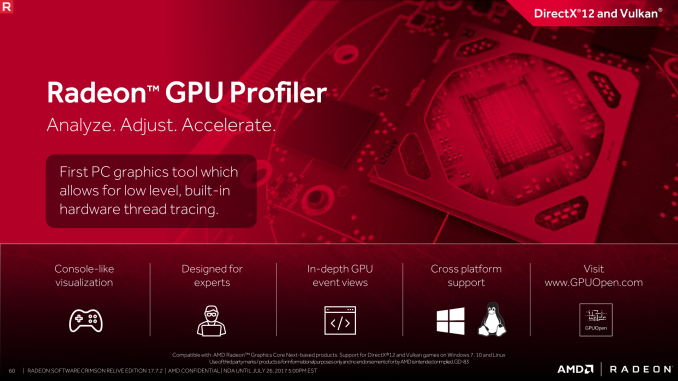
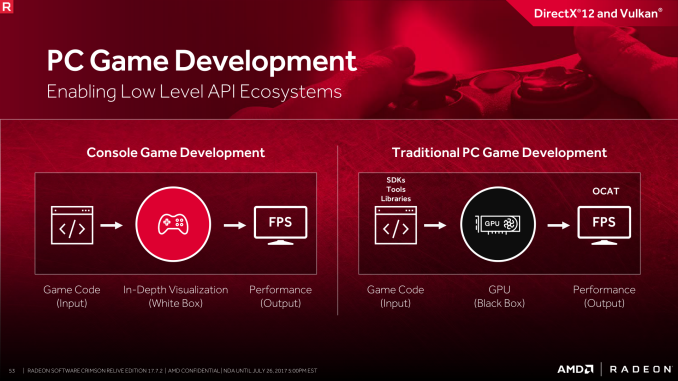

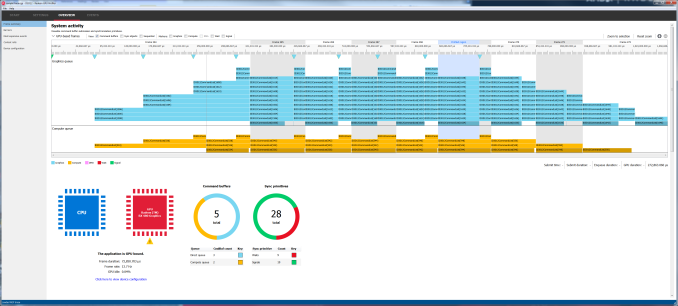
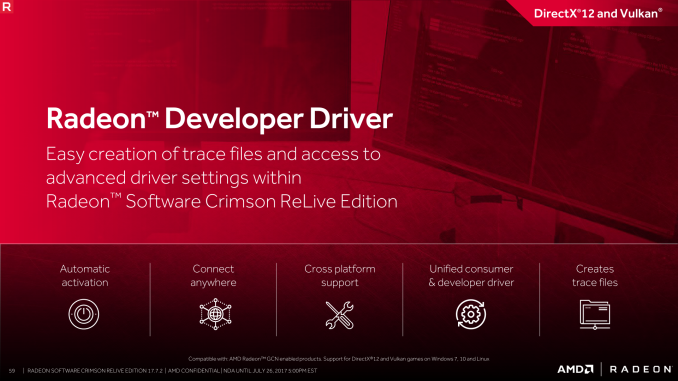
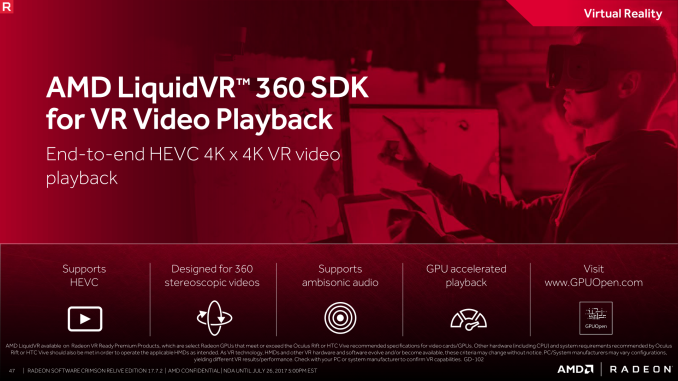
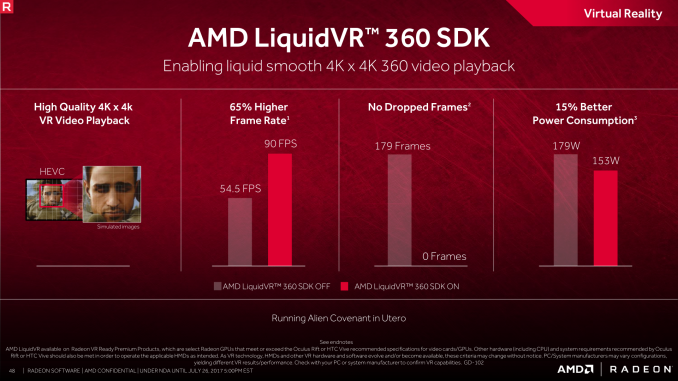
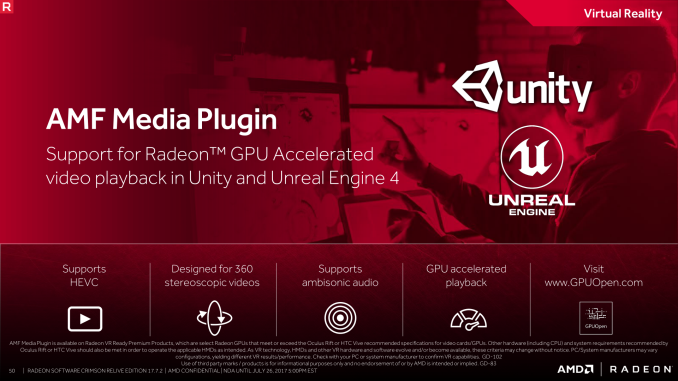








30 Comments
View All Comments
ComputerGuy2006 - Wednesday, July 26, 2017 - link
I read the title too fast, for a second I assumed they had tweaked the radeon software interface. I miss the old interface. The one that had a hierarchy on the left and the settings on the right. It was simple, intuitive and easy to use. Even after few years I am still not comfortable using this 'touch screen' type of interface, I often find myself frustrated while using it....Cryio - Wednesday, July 26, 2017 - link
Just W7 and W10 targeted improvements? No W8.1? Seems wrong.CBRworm - Wednesday, July 26, 2017 - link
AMD doesn't support W8.1 with the RX 5xx cards.Cryio - Thursday, July 27, 2017 - link
Seriously?highlnder69 - Thursday, July 27, 2017 - link
Any particular reason you are still using Windows 8.1 over Windows 10?Alexvrb - Thursday, July 27, 2017 - link
Computer plugged in, check. Display connected, check. Modern system with latest-gen discrete graphics, check. Free Windows 10 upgrade... darn it! I knew I forgot something!Alternatively, maybe alcohol was a factor?
Ascaris - Friday, July 28, 2017 - link
What do you mean "still?" I just migrated to 8.1 in February or April of this year.Once I saw that I could wall off, remove, block, or rip out the Metro stuff nearly completely, the six years of security support vs. the three for 7 made it easy. I can avoid 10 for more than half a decade now-- that's a really long time for an OS, as I think you would agree. Maybe MS will actually have a coherent thought or two by then and reverse direction. If not, that's six more years of Linux getting better (I already dual-boot it now).
Surely you must not have missed all the reasons people avoid 10.
highlnder69 - Friday, July 28, 2017 - link
I simply cannot think of one reason why anyone would want to run Windows 8.1 when you can upgrade to Windows 10 for free. What exactly don't you like about Windows 10?Ascaris - Saturday, July 29, 2017 - link
It's all been said before, but if you want me to go over it again...I don't like the spying. I don't like the forced updates. I don't like ads. I don't like "Windows as a service," aka permanent beta quality level. I don't like unwanted Candy Crush downloads, or downloads of anything else. I don't like Windows deciding to uninstall whatever it feels like, whenever it feels like. I don't like Windows deciding to replace my drivers with whatever it finds in the Windows catalog.
None of that stuff is in Windows 8.1, with the possible exception of the backported telemetry (which is also in 7 to exactly the same degree, and can be avoided or mitigated in the same way). Those are the major disqualifiers for Windows 10.
Windows 8.1 was a disaster in UI terms out of the box, but so is 10. I have used both, and I don't see 10 as a huge improvement over 8.1. Windows 8.1 has a full-screen tiled start screen; Windows 10 has the same thing scaled down to only take part of the screen. Is that really a big advantage? I can't stand tiles at all-- either way, an aftermarket start menu is going to be needed. Classic Shell, including Classic Start, is free and works very well. In both cases, as well as with Windows 7, an aftermarket tweaking tool is necessary to smooth the rough edges of File Explorer, and Classic Shell performs that task to perfection. It's so necessary that I've donated to the devs of the otherwise completely free Classic Shell; it's worth paying for.
The same is true with the File Manager's ribbon. It's one of the big issues I have with unmodded 8.1, but it has infected Windows 10 just as badly. With the ribbon being as hated as it is, why does MS insist on forcing it on people? I understand that some minority actually likes it, but most seem to dislike it... so if you must have the ribbon, make the traditional File, Edit, View... menu bar an option. Again, an aftermarket solution is necessary. Old New Explorer does it quite nicely.
I hate apps. My PC is not a phone! In Windows 8.x, they're just tacked on; nothing depends on them. I know from experience that 8.1 is perfectly stable and reliable without any of them present. A tiny utility called install_wim_tweak and a batch file dispatches all apps permanently, and that's that. They will never come back in 8.1, as 8.1 (despite being supposedly in mainstream support for one more year) only gets bugfixes and security fixes. There's not going to be some big architectural change that includes a dependency on some app, and there won't be some huge new version coming every 6 months that reinstalls them all as has happened in the past with 10 (repeatedly).
You don't know that removing apps is always going to work with 10. The last time I had 10 installed on my PC, it did have all of the 'apps' ripped out, including Cortana and Edge, but with 10's code base undergoing constant churn, there's no way to know that what worked in the last build will work in the next. Some reports from people still in 10 have validated this fear-- Windows 10 is no longer stable with Cortana removed.
You can't escape UWP in Windows 10. Many system dialogs are only in the UWP style, and this continues to get worse in each new build, as MS moves more and more functionality of the Control Panel into Settings. This process had barely started when MS abandoned 8.1 and began work on 10, and everything a person needs to do can be done in the classic Control Panel or in the MMC. As such, I've simply banished Settings on 8.1... references to it are removed from my start menu, and the tiny program called Metro Killer finishes the job, preventing the inadvertent triggering of anything Metro. Classic Shell already did away with the hot corners triggering the useless Charms, but Metro Killer makes sure.
RKCook - Friday, July 28, 2017 - link
People that avoid Windows 10 are doing so compared Windows 7.Windows 8 was quite simply a horrid abomination for a desktop or laptop OS. 8.1 did a small bit to correct the glaring defects. And then took time to fix all of the problems with Win 10.
My laptop at work crapped out and I received a Win 7 loaner for a weekend. I realized that I like 10 better.